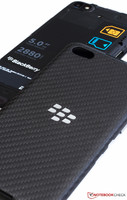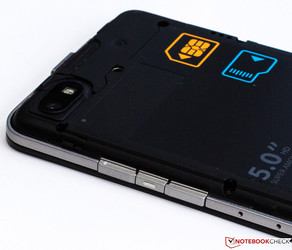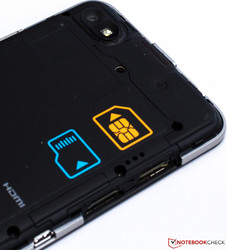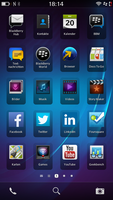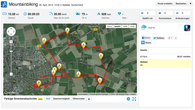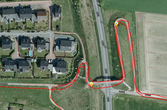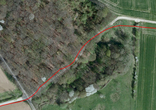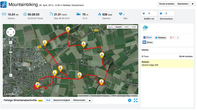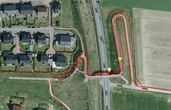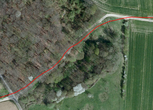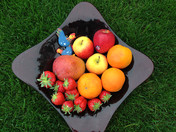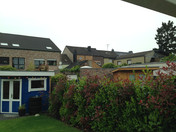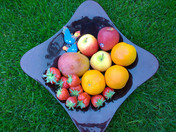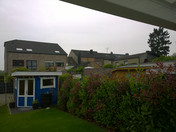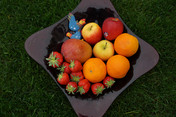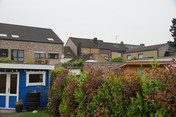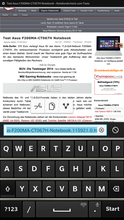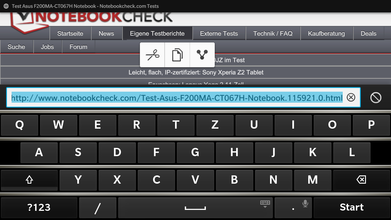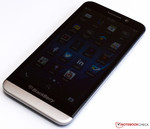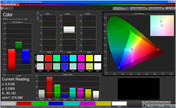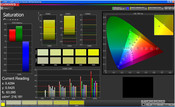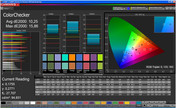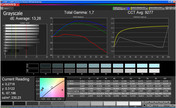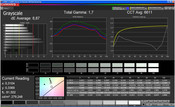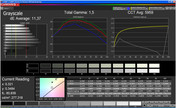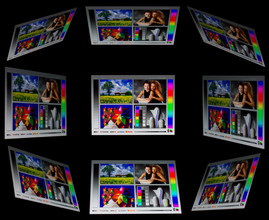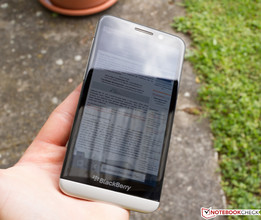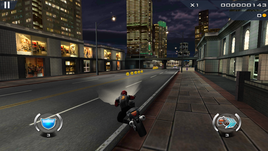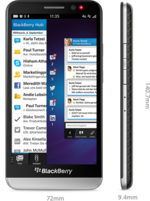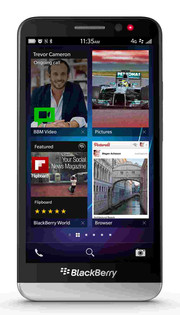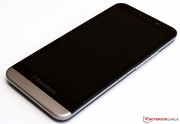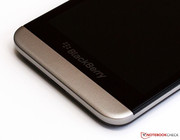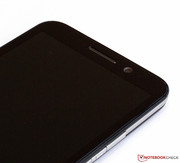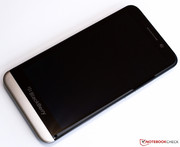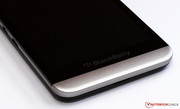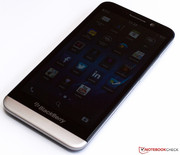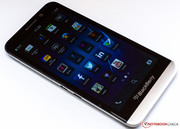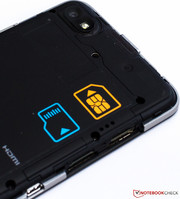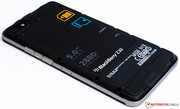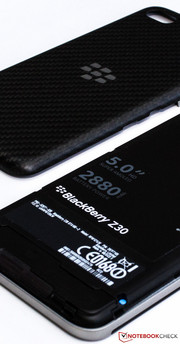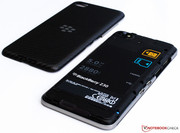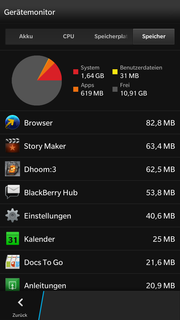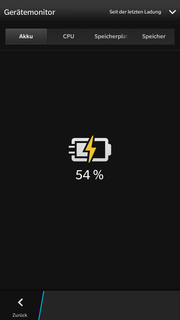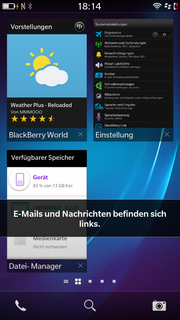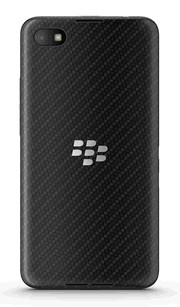BlackBerry Z30 Smartphone Review
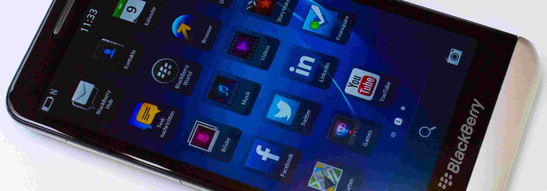
For the original German review, see here.
We dealt with the long period of development for the current BlackBerry 10 OS operating system in the review of the Z10. It would be wrong to think that something has changed about this a year later. It soon becomes evident that the focus of development has apparently not been set mainly on software but on hardware when turning on the phone and in the system settings.
The main difference compared with the precursor is noticed immediately because the screen has grown from 4.2 to 5-inches. BlackBerry also relies on an SoC from the market leader Qualcomm for its smartphones and uses the dual-core Snapdragon MSM8960T with a clock rate of 1.7 GHz per core in the Z30. At first glance, it seems as if all innovations could be counted on the fingers of one hand. We can only hope that the devil is in the details. The refreshed model from the Z-line would be set up rather weakly with only a new SoC and larger screen.
Case
As is known from BlackBerry, the build quality is very satisfying. The device is extremely stiff and can also score with solid looks. Compared with the precursor, not much has changed about the good feel: The back cover is still comprised of plastic that is rubber-coated. The smartphone is nice to hold but gets a bit heavy after a while. The Z10 was not particularly light for a 4.2-inch device with its 145 grams. The 5-inch model achieves a weight of 170 grams. The equally sized Galaxy S4 enters the race with only 130 grams, and the aluminum casing of HTC's One M8 is also lighter (160 grams). The other dimensions are 140.7 x 72 x 9.4 mm. Although LG's G2 sports a 0.2-inch larger screen, it is smaller in all other three dimensions.
Connectivity
A fat minus point is given for linking with a computer. The user is prompted to install "BlackBerry Link" when connected for the first time. Only then is the Z30 recognized as removable media and connected. Why does it have to be so complicated and only possible with additional software? This cannot be called customer-friendly, intuitive use.
Otherwise, the Z30 can score with a micro-SD slot. That enables expanding the storage within seconds for little money. A docking port and volume rocker are on the right. A multi-function button that, for example, activates voice control, is in the rocker's center. The power button is on the upper edge. A micro-USB cord or external monitor can be connected on the device's left via micro-HDMI.
Software
The BlackBerry operating system is currently still version 10, just like it was in the Z10. The exact software version of our review sample is 10.2.1.2102. This update has also been available for the BlackBerry Z10 since mid-February and is installed via an OTA update.
The main differences to the former software version is, for example, the reworked monitoring for battery activity, detailed features for corporate customers, an offline browser-reading mode, or freely configurable quick settings. All innovations and improvements can be followed in various blogs.
Naturally, the manufacturer installs loads of bloatware. Apps like Twitter, BlackBerry Remember or LinkedIn are pre-loaded, and some unnecessarily reserve storage capacity. Like all BlackBerry devices, the rise and fall of success is partially associated with the offer in the corresponding app store. There were approx. 120,000 apps available in mid-2013, but most of them were unfortunately not free of charge. Google's Play Store had this amount of apps available 2.5 years earlier. Apple or Android users will find it difficult to switch to BlackBerry because unpleasant surprises await users who are used to a generous supply.
Communication & GPS
Although quite some time has gone by since the review of the precursor, not much has changed in this sector. The Wi-Fi module still transmits in dual-channel mode (2.4 and 5 GHz) and still has a good range. It supports the 802.11 a/b/g/n standards. The Z30 connects to mobile Internet via LTE when there is no wireless LAN available and the corresponding plan has been selected from the provider (quad-band LTE (1800/2600/900/800 MHz); quad-band UMTS/HSPA+ (800/850/900/1900/2100 MHz)). Bluetooth 4.0 LE (low energy) is installed for short-range data transmissions. NFC technology is also available for near field communication.
The a-GPS module had to directly compete with the Garmin Edge 500 outdoor navigation system. The results of both were very close, and the difference was only 40 meters which can be neglected. We noticed a very accurate tracking of the driven route especially in parts with tight curves. It was a bit less accurate in wooded areas, but the Garmin reference device also has problems with these sections.
Telephony and Speech Quality
We praised the Z10's speech and audio quality. We did not find any flaws or shortcomings in the new model either. The sound is loud and clear and can be set to a sufficient volume. The included in-ear headphones can also be used as a headset. We do not have any reason for complaints here because the quality of this accessory is convincing.
Cameras & Multimedia
Two cameras are installed in our review sample. A 2-megapixel camera with a triple digital zoom and image stabilizer is on the front. It enables recording videos in HD quality (720p). The rear-facing camera is more interesting because the lens has a maximum resolution of 8 megapixels and features an LED flash. The lens is light sensitive with a maximum aperture of f2.2 and could theoretically even achieve acceptable results in darker surroundings. Unlike the front-facing camera, the primary camera can record Full HD videos.
Despite the lens' high light sensitivity, the small sensor does not capture enough light to display the object brightly. This is noticed extremely in the screenshot "Surroundings." Other smartphones, such as the Lumia 1020, do a much better job here. We noticed another point of criticism in the fruit bowl shot. The fruits' colors are natural, but not that of the bowl. The bowl looks deep purple on the picture, but that is wrong. The reproduction of details satisfies us as far as an 8 MP camera can.
Accessories and Warranty
The accessories included for the Z30 are limited to the smartphone itself, i.e. the battery and an in-ear headset. Including a headset is not surprising in this price range, but more appropriate.
Unfortunately, only a manufacturer's warranty of 12 months is included. Buyers who want to cover the pricey smartphone beyond this warranty period will have to look around for third-party cell-phone insurance.
Input Devices and Controls
The capacitive touchscreen is absolutely impressive because its accuracy is on a very high level and does not leave anything to be desired. Even the smallest hyperlink in the browser is hit accurately, no matter whether it is in the corner or in the center of the 5-inch screen. Of course, the smartphone supports multi-touch gestures. The pinch-to-zoom feature functions impeccably on websites, and the zoomed-in text is available in a razor-sharp quality immediately - without loading delays.
The virtual QWERTY keyboard is used for typing. The keys have a sufficient size to write shorter texts within a relatively short time. The keyboard takes up a lot of space on the screen in landscape mode, but a good compromise of keyboard size and readable content is made when the phone is rotated by 90 degrees.
Display
As mentioned, the screen has a size of 5-inches. The Z10's screen is 0.8-inches smaller but has a virtually identical resolution. The review sample does not feature an exceptional configuration with 1280x720 pixels. Full HD videos recorded using the primary camera cannot be rendered in the maximum resolution on the internal screen. Furthermore, the screen has a color depth of 24 bits and an aspect ratio of 16:9. The Super AMOLED screen is one of the biggest differences compared with its precursor (LCD screen). The average brightness is 277.9 cd/m²; the Z10 achieved an amazing 655.9 cd/m². The illumination has been improved to a very homogeneous 91%, and the black level is almost 0 cd/m² for construction-related reasons. This results in a non-measurable contrast - a feature of AMOLED technology.
| |||||||||||||||||||||||||
Brightness Distribution: 91 %
Center on Battery: 275 cd/m²
Contrast: ∞:1 (Black: 0 cd/m²)
ΔE ColorChecker Calman: 10.25 | ∀{0.5-29.43 Ø4.79}
ΔE Greyscale Calman: 8.87 | ∀{0.09-98 Ø5}
Gamma: 1.7
CCT: 6611 K
Another feature of the screen's technology is seen when looking at the color reproduction. It is very rich, which is one reason why many buyers avoid AMOLED screens. Three modes can be selected in the grayscale reproduction. The medium setting has a color temperature of 6611 K, which lets all gray hues look a bit warmer than specified in the ideal. We measured a temperature of 9277 K in the cold setting and observed very bluish gray hues.
Not only the screen's brightness has an impact on good outdoor legibility. The black level and contrast also contribute significantly to the suitability - and these rates could not be better. Content can be read sufficiently well when the viewing angles are altered a bit and the user takes care not to expose the screen to maximum sunlight.
Performance
BlackBerry uses an SoC from Qualcomm for its Z30. The S4 Pro MSM8960T has two cores that clock with 1.7 GHz each. The smartphone is sufficiently designed with a 2 GB working memory, which is noticed when moving through the BlackBerry World. Everything runs smoothly and without lags.
The lack of benchmarks in the BlackBerry World prevents performing many benchmarks. We could only download the Geekbench 3 runtime test and compare the results with other smartphones in our database. The Z30 looks like an old hat compared with premium phones from other manufacturers. Only Google's Nexus 5 scores worse by 18% in the single-core test.
| Geekbench 3 | |
| 32 Bit Multi-Core Score (sort by value) | |
| BlackBerry Z30 | |
| Samsung Galaxy S5 | |
| Apple iPhone 5S | |
| HTC One M8 | |
| LG G2 | |
| Google Nexus 5 | |
| 32 Bit Single-Core Score (sort by value) | |
| BlackBerry Z30 | |
| Samsung Galaxy S5 | |
| Apple iPhone 5S | |
| HTC One M8 | |
| LG G2 | |
| Google Nexus 5 | |
An app is not needed to perform browser-based benchmarks. It can be done easily using the pre-loaded browser. The Peacekeeper benchmark recurrently crashed so that we could not ascertain any scores. The same is true for the SunSpider version 1.0 test. Unfortunately, the results here also speak clearly. All contending products achieve considerably better scores. Nevertheless, we cannot say that the browser is sluggish or that longer waiting times occur subjectively.
| Mozilla Kraken 1.0 - Total (sort by value) | |
| BlackBerry Z30 | |
| BlackBerry Z10 | |
| Apple iPhone 5S | |
| LG G2 | |
| Google Nexus 5 | |
| Octane V1 - Total Score (sort by value) | |
| BlackBerry Z30 | |
| BlackBerry Z10 | |
| Apple iPhone 5S | |
| LG G2 | |
| Google Nexus 5 | |
| Octane V2 - Total Score (sort by value) | |
| BlackBerry Z30 | |
| Samsung Galaxy S5 | |
| HTC One M8 | |
| Google Nexus 5 | |
| Google Nexus 5 | |
| Sunspider - 0.9.1 Total Score (sort by value) | |
| BlackBerry Z30 | |
| BlackBerry Z10 | |
| Apple iPhone 5S | |
| LG G2 | |
| Google Nexus 5 | |
* ... smaller is better
Games and Videos
Smartphones like to be used as a portable gaming console to kill time in the subway or the lunch break. Games have to be downloaded from the BlackBerry World for this purpose. The selection is not very lush, and a fee is charged for many games. The supply cannot be compared with that of the Play Store or App Store. When an appropriate game has been found, even relatively demanding games runs smoothly. We tested that with Dhoom: 3, a first-person action shooter/racing game.
Users who prefer watching a video will also be satisfied with the Z30 and its 5-inch screen. Full HD videos were rendered impeccably.
Emissions
Temperature
BlackBerry has the temperature development under control. We did not measure above average temperatures in the precursor, and the rates in the load and idle scenario have even been improved so that absolutely no unpleasant heat is produced. The temperatures without load remained clearly below 30 °C, and the rates only fluctuated between just 31.7 °C and 32.2 °C even when the SoC was loaded.
(+) The maximum temperature on the upper side is 33.1 °C / 92 F, compared to the average of 35.2 °C / 95 F, ranging from 21.9 to 247 °C for the class Smartphone.
(+) The bottom heats up to a maximum of 32.9 °C / 91 F, compared to the average of 34 °C / 93 F
(+) In idle usage, the average temperature for the upper side is 27.2 °C / 81 F, compared to the device average of 32.9 °C / 91 F.
Speakers
The speaker is located on the back. It is not completely covered when the smartphone is placed on an even surface because it is exactly on the corner of the rounded edge. The maximum volume is absolutely sufficient but should not be maxed out because the sound is then tinny. External speakers can be connected to the Z30 either via the 3.5 mm jack or wirelessly.
Energy Management
Power Consumption
The precursor consumed between 0.3 and 1.7 watts during low load. The Z30 sports a 0.8-inch larger screen, and its performance has also improved. However, the power consumption is almost the same. Although the lowest rate is approximately 0.4 watts, the maximum idle settles to around 1.6 watts.
The load consumption of both devices deviates more strongly. The Z30 consumes between 1.9 and 3.6 watts, and the Z10 needs a bit more with 2.3 to 3.7 watts. We will look at the battery runtimes in the next section, but it is already obvious here which device will be more enduring.
| Off / Standby | |
| Idle | |
| Load |
|
Key:
min: | |
Battery Runtime
The 2880 mAh battery of the Z30 is over 1000 mAh stronger than in the Z10. This is noticed immediately in the Z30's runtime. We simulate the minimum runtime using maximum screen brightness, enabled wireless modules, and the highest possible SoC load (Full HD video playback). The phone first had to be recharged after 5 hours and 40 minutes. The Z30's battery also scored in both other test scenarios and clearly surpassed the Z10. Overall, BlackBerry has noticeably improved the battery runtimes. It is possible to easily get through a day without recharging.
Verdict
The Canadian manufacturer does not give up and consistently tries to establish itself on the smartphone market. That is certainly not easy considering the strong competition and their short product cycles. The Z30 has grown by 0.8-inches, its processor has been upgraded to 1.7 GHz, and the working memory has also been expanded to 2 GB. The hardware is compelling because the smartphone features a high-quality build, and the properties of the Super AMOLED screen are satisfactory. However, not much has changed compared with the Z10, and profound innovations are not discovered.
BlackBerry has a twice-as-hard job because it also develops the software. The operating system actually functions perfectly, and its use is intuitive. The problem and the deduction of 1% on our part lie in the fact that not many apps are available in the BlackBerry World. Consequently, users who want an extensive offer of apps should look at another manufacturer. The Z30 is currently available for approximately 430 Euros (~$584) in online shops. The precursor costs about half as much. A comparably priced Android smartphone would, for example, be the Galaxy S4 or Nexus 5 (32 GB).




